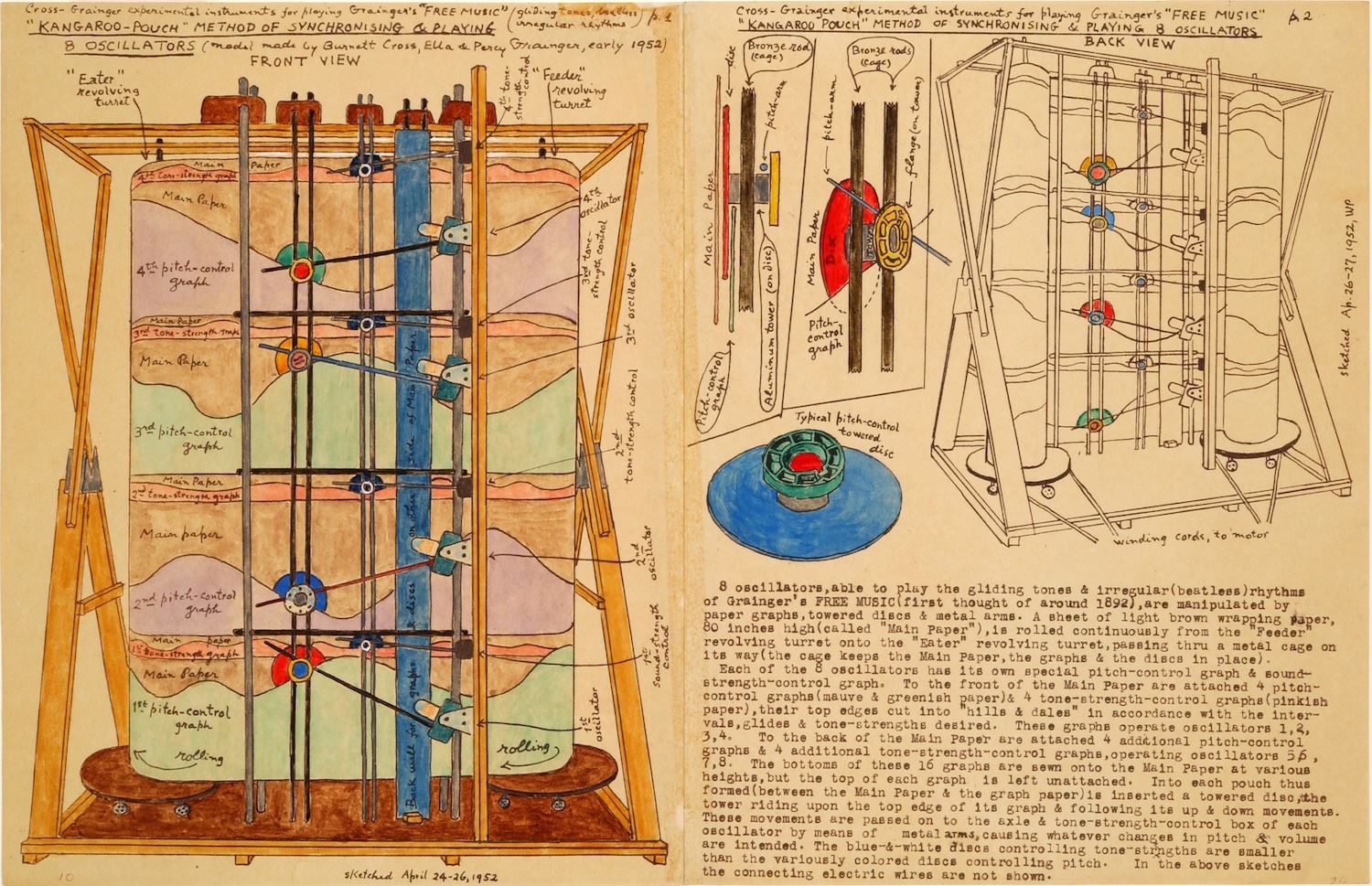
With the conservation and installation of Gliding Tones on Whistle, Notes on Recorders, the Percy Grainger Society fabricated 2 information panels which are now on display together with the free music machine in the dining room of the Percy Grainger Home and Studio. What follows here is the text of the first panel, "Percy Grainger and Free Music", as written by Dr. Paul Jackson, PGS Board President.
For Percy Grainger, Free Music drew its inspiration from the sounds of nature and was music free from the constraints of conventional rhythm and individual pitch. From an early age, he imagined music that would glide continuously across the pitch spectrum, without the need for metrical rhythms and, ultimately, without the need for a performer; the composers’ ideas would be translated directly into sound.
‘I have heard free music in my head since I was a boy of eleven or twelve … it is my only important contribution to music.’
Elements of Free Music can be found in much of Grainger’s instrumental and vocal compositions, where the use of sliding notes and irregular rhythms often feature. Between 1935 and 1937, Grainger wrote three short pieces – Free Music No. 1, Free Music No. 2 and Beatless Music – which further demonstrated his ideas in practice. Following a meeting with the Russian inventor Leon Theremin in 1932, Grainger composed the pieces for theremins, instruments able to produce continuously gliding tones without direct contact from the player. The works also called for a new method of musical notation, Grainger devising a system that used graph paper to indicate pitch contours and changes in volume. These pieces are among the earliest examples of pitchless music.

 Grainger regarded all of his music up to this point as merely a stepping-stone to the full development of Free Music, and he was to increasingly devote his time to this from the late 1940s onwards as his activities as a concert pianist began to decline. Using his White Plains home as a studio, he worked alongside his wife, Ella, and in close collaboration with a young physicist, William Burnett Cross. Together they designed and built machines that were able to produce Free Music without the involvement of a human performer. Grainger and Cross made audio recordings of their experiments and documented their work with a number of evocative photographs. Grainger, a talented artist, also produced color drawings of several of the machines, including explanations of their working methods.
Grainger regarded all of his music up to this point as merely a stepping-stone to the full development of Free Music, and he was to increasingly devote his time to this from the late 1940s onwards as his activities as a concert pianist began to decline. Using his White Plains home as a studio, he worked alongside his wife, Ella, and in close collaboration with a young physicist, William Burnett Cross. Together they designed and built machines that were able to produce Free Music without the involvement of a human performer. Grainger and Cross made audio recordings of their experiments and documented their work with a number of evocative photographs. Grainger, a talented artist, also produced color drawings of several of the machines, including explanations of their working methods.
‘Free Music … is the goal that all music is clearly heading for now and has been heading for through the centuries. It seems to me the only music logically suitable to a scientific age.’
Most of the machines, which were given typically Graingeresque names such as the Hills & Dales Air-Blown Tone-Tools, the Side-Ridge Clothes-Line-&-Scotch-Tape-Tin Oscillator-Player, and the Kangaroo-Pouch Method of Synchronising & Playing 8 Oscillators, were constructed from wood, paper, cardboard, string, and other found objects scavenged from the house, local hardware stores and the immediate locale. The machines were in a constant state of flux and were often dismantled or repurposed as soon as sounds were recorded. The final machine, the Electric Eye, remained unfinished at the time of Grainger’s death, but was the most sophisticated and was able to produce seamless electronic pitch glides by ‘reading’ graphic notation painted on clear film. It is this machine that places Grainger’s experiments in electronic music squarely alongside other composers whose work in these areas has historically gained more attention.

The conservation of Gliding Tones on Whistle, Notes on Recorders was supported through the NYSCA/GHHN Conservation Treatment Grant Program administered by Greater Hudson Heritage Network. This program is made possible by the New York State Council on the Arts with support of the Office of the Governor and the New York State Legislature.